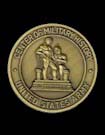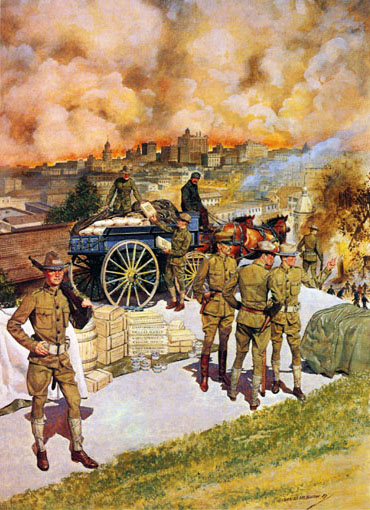
"Thank God for the Soldiers"
San Francisco Earthquake, 1906
One of the greatest natural disasters in United States history, the San Francisco Earthquake, occurred on 18 April 1906 at about 5:15 a.m. The shift in the San Andreas fault toppled numerous chimneys, severely damaged others, and opened gaping cracks in the cobblestone streets. But the havoc wrought by the trembling earth was only the beginning. Almost immediately fires, fueled by debris and gas escaping from broken lines, sprang up in various sections of the city. Unfortunately, the quake also damaged water mains and to halt the spreading fires city officials decided to dynamite buildings to create fire lanes. The city fire chief sent an urgent request to the Presidio, an Army post on the edge of the stricken city, for dynamite. Brigadier General Frederick Funston, commanding the Department of California and a resident of San Francisco had already decided the situation required the use of troops. Collaring a policeman he sent word to the Mayor of his decision to assist. Martial law was never declared, however, and troops took guidance from civilian authorities.
During the first few days soldiers provided valuable services patrolling streets to discourage looting and guarding buildings such as the U.S. Mint, post office, and county jail. They aided the fire department in dynamiting to demolish buildings in the path of the fires. The Army also became responsible for feeding, sheltering, and clothing the tens of thousands of displaced residents of the city. This support prompted many citizens to exclaim, "Thank God for the soldiers!" Under the command of Maj. Gen. Adolphus Greely, Commanding Officer, Pacific Division, Funston's superior, over 4,000 troops saw service during the emergency. On 1 July 1906 civil authorities assumed responsibility for relief efforts and the Army withdrew from the city.
As fires rage through San Francisco soldiers, dressed in olive drab service dress with strapped leggings and wearing campaign hats with light blue cords designating infantry, unload one of many civilian wagons pressed into service with their drivers. (In addition to supplies from Army depots, food, including much flour, came from cities all over the United States.) The officer with the black visored service cap is a lieutenant colonel of infantry. With his olive drab, single breasted sack coat, with four chokedbellow pockets, low falling collar and dull finish bronze metal buttons he wears olive drab service breeches and russet leather boots. The officer and the artillery sergeant known by his scarlet hat cord carry .38 caliber service revolvers; the rifles shown are the new .30 caliber 1903 "Springfields."
|
Disaster Strikes
18 April 1906 |
| |
|
SC95197 - Vivid picture showing flames of San Francisco fire in the area east of Sansome Street; north of Bush Street, south of Jackson Street, and west of Embarcadero Street. The unburned area shown here is the Chinatown District. |
| |
|
SC95215 - Area in the vicinity of Kearny, Third, Market and Geary Streets. The large building is the Claus Spreckels or Call Building. Flames can be seen coming from the windows of the Call Building. The Mutual Bank building and other structures in the foreground were not consumed by fire at this time but in later pictures the whole area was in ruins. |
| |
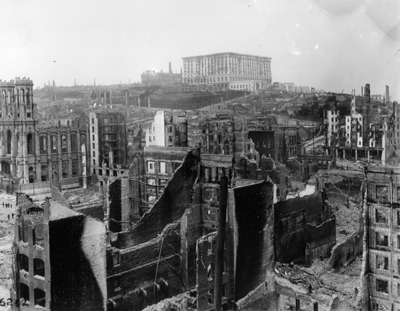 |
SC95232 - Area east of Taylor Street; west of Grant Avenue, south of Sacramento Street; and north of Sutter Street. The large white building in the background is the Fairmont Hotel. |
"Thank God for the Soldiers!"
The Army and the Relief Effort |
|
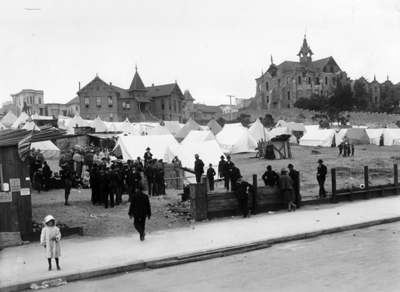 |
SC95201 - The Army established and administered numerous refugee camps, to include the one pictured here in the vicinity of Haight Street and Central Avenue. |
| |
 |
SC95222 - Refugee camp established within the Presidio of San Francisco. |
| |
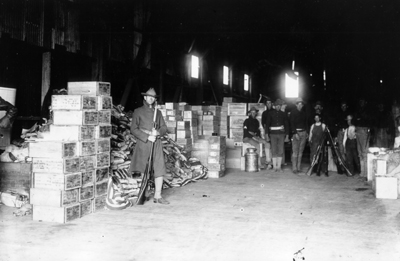 |
SC95176 - Soldiers guarding relief supplies in San Francisco after the earthquake. |
| |
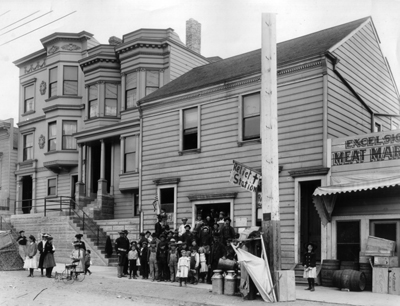 |
SC95138 - Exterior view of one of the many relief stations established by the U.S. Army after the earthquake. |
| |
|
SC90581 - Brigadier General Frederick Funston (undated but probably before 1906)
|
| |
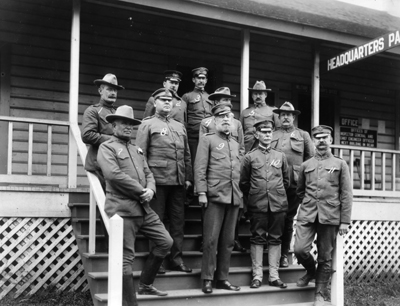 |
SC95082 - Some of the staff officers of the Pacific Military Division at the time of the San Francisco Earthquake (pictured here at the Presidio):
Back Row (left to right they are numbered 1 through 6): Lieutenant Colonel Lea Febiger, Captain Frank L. Winn, Major Henry B. Moon, Captain W.W. Hartz, Captain W.G. Haan, and Lieutenant Colonel G.K. McGunnegle.
Front Row (left to right they are numbered 7 through 11): Lieutenant Colonel W.L. Pitcher, Major General S.W. Dunning, Major General A.W. Greely, Colonel Sedgewick Pratt, and Major C.A. Devol.
|
| |
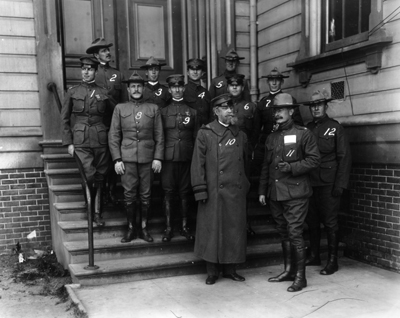 |
SC95084 - Military officers who participated in the San Francisco Earthquake relief operations:
Back Row (left to right they are numbered 1 through 7) Captain William Mitchell, Captain W.W. Hartz, Captain L.W. Oliver, Captain R.E. Logan, 2nd Lieutenant J.R Benedict, Captain J.F. Madden, and 2nd Lieutenant E.S. Adams.
Front Row (left to right they are numbered 8 through 12) 1st Lieutenant H.H. Scott, Captain R.S. Sorley, Major General A. W. Greely, Lieutenant Colonel Lea Febiger, and Captain F.D. Ely. |
| |
|
|
EARTHQUAKE IN CALIFORNIA
Special Report of Maj. Gen. Adolphus W. Greely
Extracted from: Annual Reports of the War Department, Vol I, 1906, pp. 91-253.
|
|
|
|
Last updated 10 April 2006
|
|
